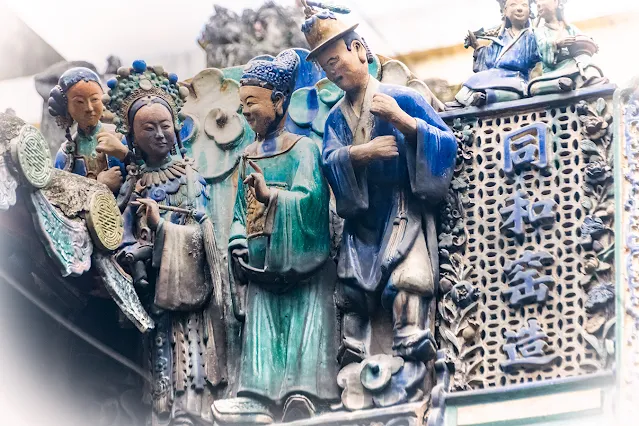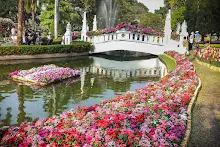A photoblog of stories, events, culture and travel. Let the images tell you what I see.
Friday, January 18, 2019
Friday, January 11, 2019
Colourful Festivals of Malaysia - Thaipusam
 |
| A female devotee rolling on the ground until the steps of the caves as part of her penance. Helping her along the way are her family members. |
In Penang, there are many locations where the devotees are pierced. The market area of Lorong Kulit (behind the city stadium) is where the large kavadis are placed onto the devotees and a good place to catch glimpses of those scary piercings.
Sunday, November 25, 2018
Loy Loy Krathong...
 วันเพ็ญเดือนสิบสอง
วันเพ็ญเดือนสิบสองน้ำก็นองเต็มตลิ่ง
เราทั้งหลายชายหญิง
สนุกกันจริงวันลอยกระทง
ลอย ลอยกระทง
ลอย ลอยกระทง
ลอยกระทงกันแล้ว
ขอเชิญน้องแก้วออกมารำวง
รำวงวันลอยกระทง
รำวงวันลอยกระทง
บุญจะส่งให้เราสุขใจ
บุญจะส่งให้เราสุขใจ
wan pen deuan sìp sŏng
náam gôr nong dtem dtà-lìng
rao táng lăai chaai yĭng
sà-nùk gan jing wan loy grà-tong
loy loy loy grà-tong
loy loy loy grà-tong
loy grà-tong gan láew
kŏr chern nóng gâew òk maa ram wong
ram wong wan loy grà-tong
ram wong wan loy grà-tong
bun jà sòng hâi rao sùk jai
bun jà sòng hâi rao sùk jai
Tuesday, October 09, 2018
Welcoming the Nine Emperor Gods @ Ampang
 |
| Going out to get the Nine Emperor Gods.... |
 |
| Here come the Nine Emperor Gods... escorting the urn back to the temple. |
Monday, October 08, 2018
The Festival begins at Ampang Nine Emperor Gods Temple
Sunday, October 07, 2018
Time for Nine Emperor Gods Festival 2018
Sunday, August 05, 2018
The View from Above - The Black Virgin Mountain
The Black Virgin Mountain or Núi Bà Đen in Tây Ninh Province of Vietnam is the highest peak in Southern Vietnam. The hill is actually an almost perfect cinder cone of an extinct volcano (which gives it its distinctive shape) and is a popular tourist spot. You can take the gondola up the hill and then opt to take the more exhilarating luge ride back down. The upper gondola station gives you a lovely view of the plains below.
 |
| View from the top station of the Núi Bà Đen gondola lift. |
Friday, August 03, 2018
Thursday, August 02, 2018
Timeless Charm of Bà Thiên Hậu (Thien Hau Temple) in Saigon
If you are in District 5 of of Saigon, do make it a point to see the Thien Hau Temple there. Officially known as Chùa Bà Thiên Hậu (Pagoda of the Lady Heaven Empress aka Mazu), the temple is quintessentially Chinese in architecture. Whilst there are many Mazu temples elsewhere around the world that are bigger, or more grand, this temple is unique as it has that old school charm typical of Chinese diaspora temples.
Look at the roof ceramic diorama, the altar decorations and setup, and donation slips being hung in the temple, and you get transported back in time to when the temple was possibly the grandest ever built at that time in that area and was the focal point of the Chinese community in Saigon. Indeed this is one of the many temples that carries the timeless charm of old Saigon, Vietnam.
Thursday, May 03, 2018
Nature's Revenge... The Forlorn Remains of Danushkodi's St Anthony Church
 |
| The front facade of the church ruins. |
Tuesday, February 06, 2018
The Colours of Spring... Chiang Mai Flower Festival
 |
| The colours of spring...tulips at Chiang Mai Flower Festival 2018 |
Sunday, March 26, 2017
Weaving by the Sea
 |
| Weaving by the sea - with a view of the seafront at Galle. |
 |
| Using strips of the coconut spathe (flower stalk sheath) as twine to bind the basket. |
Wednesday, March 15, 2017
Everlasting Flower Lady of Ooty

Sunday, February 26, 2017
I Feel Pretty...
 |
| Shot at 38mm, ƒ/6.3, 1/40s, ISO 1000 with a Nikon D5300 and Tamron AF 18-270mm F3.5-6.3 Di II VC PZD lens. |
Saturday, February 04, 2017
Divine prediction... Fire Watching at Penang Ban Ka Lan Snake Temple
 |
| Getting them lit... Devotees throng to the Snake Temple to offer joss-sticks and candles on the eve of Chor Soo Kong's birthday. |
 |
| Deep in prayer...the never ending flow of devotees that come to pray to Chor Soo Kong on the eve of his birthday. |
As midnight approaches, an entourage will arrive with Taoist priest and a censer burner on a wooden carrier that will be placed in front of the deity on the main altar. After a short ceremony, joss sticks will be lit and passed to the committee members of the temple. These joss-sticks are then collected back after the members have offered their prayers and the tops snapped off and placed into the censer. The celebrant will then start the fanning until the embers burst into flames. The intensity, height and durability of this flame that is used as a prediction of Penang's quarterly economic state. This process will then be repeated two more times to obtain the prediction for the entire year.
When all three flames have been observed, the celebrant adds a sandalwood block and powder, and all present will rush forward to be blessed by the sandalwood smoke from the burner. When all inside have had their 'blessings', the censer and the carrier are taken out of the temple. There will then be other Chor Soo Kong temples who will also come with their censer in a carrier basket and perform the fire watching ceremony, which is usually used to predict their member's or organisation's luck in the coming year (as opposed to the entire state of Penang in the first one).
 |
| Flames that predict the economic well-being of Penang... the fire watching ceremony of Penang Snake Temple. |
Monday, January 30, 2017
Coming up - Thaipusam 2017
Vel! Vel! Veeravel! Vel! Vel! Vetrivel!
Son: Ooo, magic Vel (spear)!
Mother: Yes dear, now go play outside, don't make a mess in here...
Son: Can I go play (beat up) with the (bad) kid next door, Soorapadman? Please, please?
Mother: Ughhh... just play nice, OK?
Son: Okay Mommy (YES! I am so gonna split him in half)
Friday, December 02, 2016
Faces of Nepal - The Shopkeeper
Thursday, December 01, 2016
Scenes from Kashmir - Row row row your boat...
 |
| Row, row, row your boat... |
Wednesday, November 30, 2016
Kashmir - of Kangri pots, Pheran cloaks, and the men and women who use them
 |
| The Kangri or wicker basket brazier / fire-pot. |
 |
| A Kashmiri men in pheran with his kangri by the rodside near him (by the green post). |
 |
| They are NOT pregnant - they are just keeping their pots in there. These women in pheran seemed to carry their pots a little higher that the men do. |
 |
| No, she is not handicapped and definitely not pregnant! She is merely holding the kangri with her right hand. |
 |
| The water bong and a kangri - all that a man would need in Kashmir. |
 |
| The fire-pot man in Pahalgam - see this post about him: Faces of Kashmir - The Fire-Pot Man |
 |
| The women of the family are responsible for the hard work of bringing in the firewood for the charcoals. |
Tuesday, November 29, 2016
Faces of Kashmir - The Fire-Pot Man

See this post as well regarding the Kangri in Kashmir - of Kangri pots, Pheran cloaks, and the men and women who use them.
Landscapes of India - Kashmir

Friday, November 25, 2016
Faces of Kashmir - Gulmarg Sleigh Puller
Thursday, November 24, 2016
Faces of Nepal - The Souvenir Seller
Friday, October 21, 2016
The Spirit that Remains.... In Memory of Rev RS Hutchings and the School that He Founded - PFS
Thursday, October 06, 2016
The Heat Is On - Nine Emperor Gods Festival at Jinjang
 |
| Runing through the flames |
 |
| Huat (發) ahhhh.... or is it Hot ahhhhh!!!! |
 |
| Live view of the piercing action.... |
Ampang Nine Emperor Gods Festival - What We Love and Hate About The Festival No.3
 |
| The floor filled with offering buns, joss-paper, rice and fruits at Ampang Nine Emperor Gods. |
Wednesday, October 05, 2016
Ampang Nine Emperor Gods Festival - What We Love and Hate About The Festival No.2
 |
| Stinky tofu sign along the street leading to the Ampang Nine Emperor Gods Temple. |




















